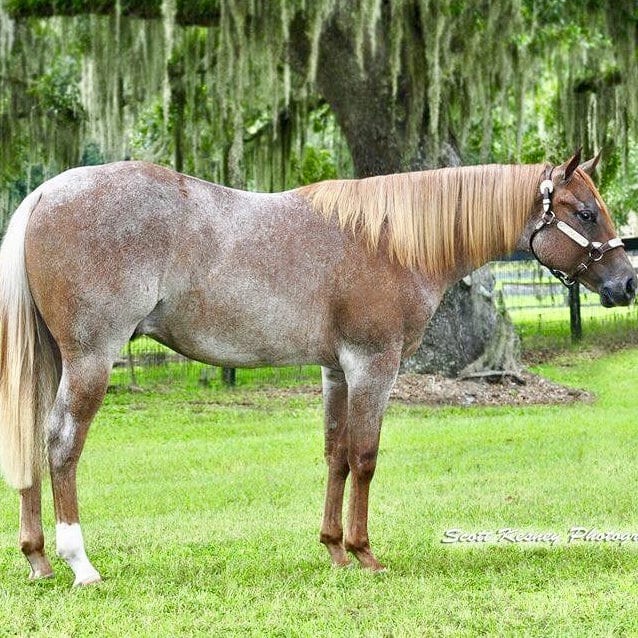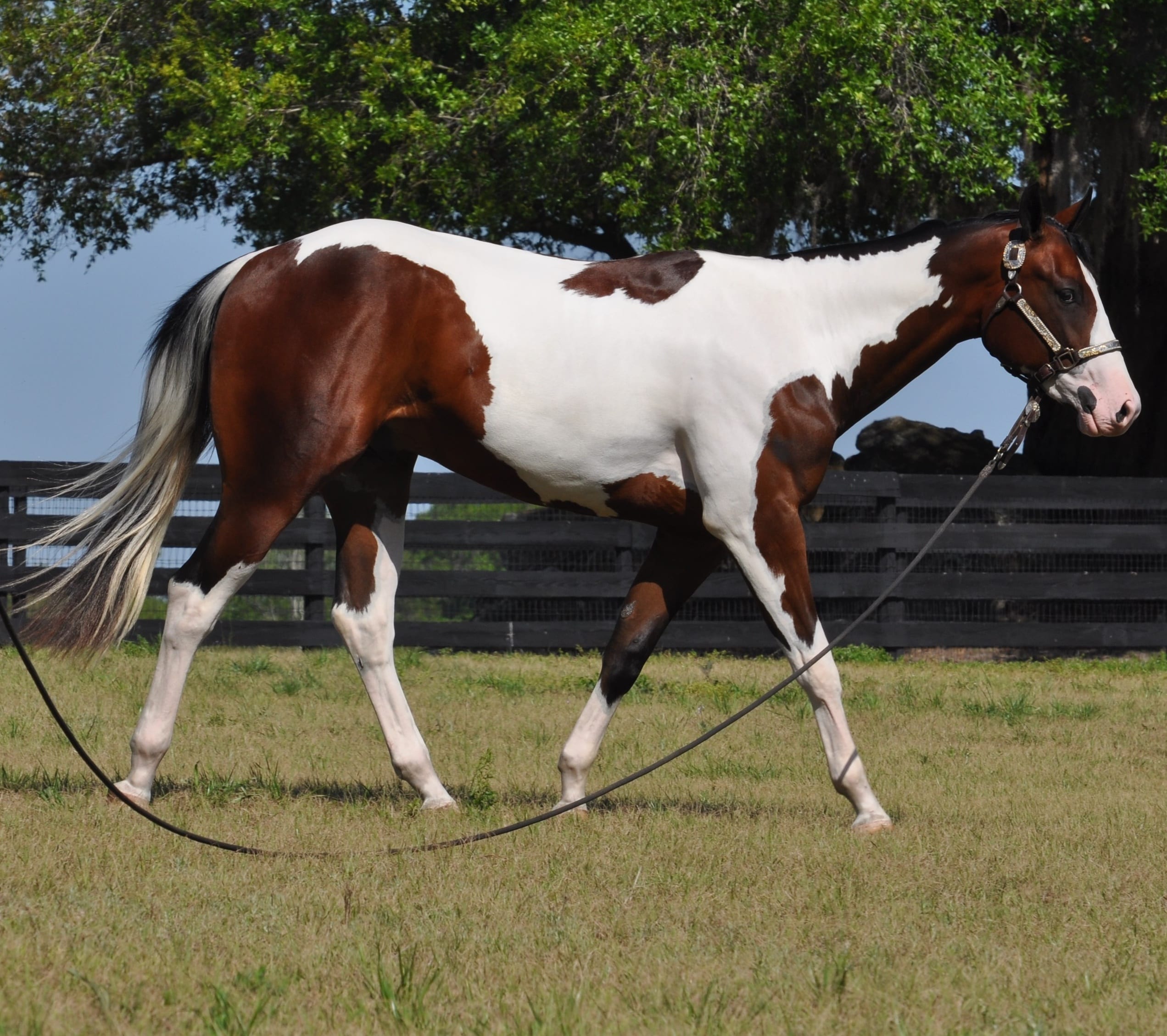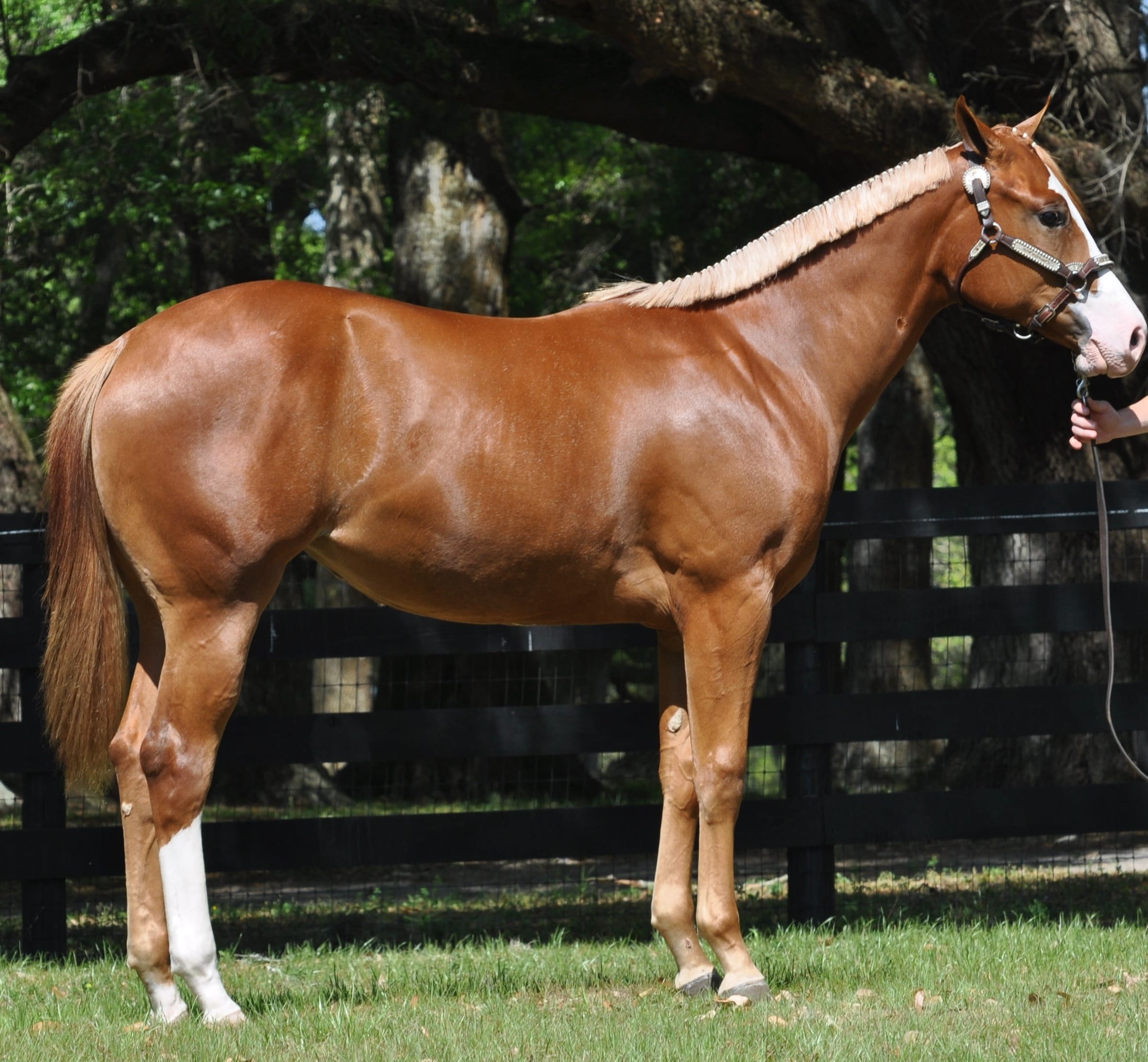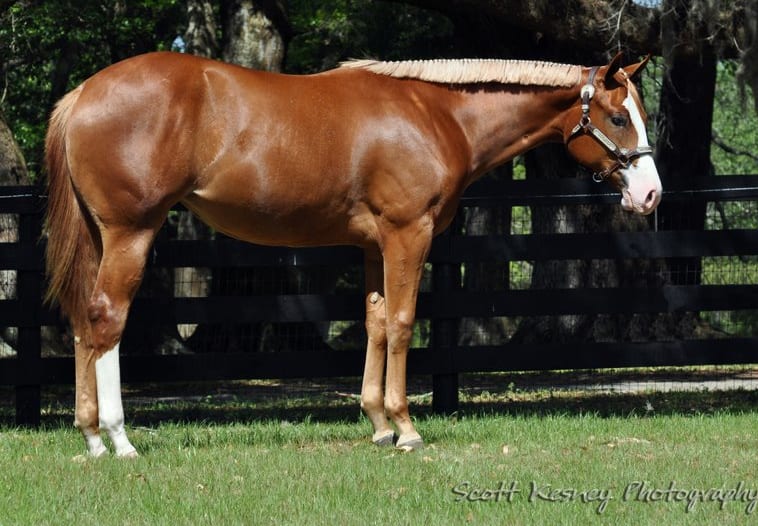We’ve all seen them: bad horse ads.
While scouring the internet for that next prospect, we find a horse for sale that may show a lot of potential, but the ad is all wrong.
The pictures are terrible, the video may be worse, and the write-up is full of typos, incorrect terminology, and over-exaggerated descriptions.
Slow the train, folks!
Top luxury brands like Mercedes-Benz and Gucci don’t sell their products with poor marketing. In fact, the ability to sell a luxury item greatly depends upon how it is marketed.
It shouldn’t be a surprise that the same goes for horses.
 GoHorseShow sat down with VS Code Blue owner Jan Pittman of The Pittman Ranch in Chipley, Florida, and also the owner of Without Limits, a legal marketing media firm in Panama City, Florida, as well as the Ranch’s breeding manager, Scott Kesney. (pictured right)
GoHorseShow sat down with VS Code Blue owner Jan Pittman of The Pittman Ranch in Chipley, Florida, and also the owner of Without Limits, a legal marketing media firm in Panama City, Florida, as well as the Ranch’s breeding manager, Scott Kesney. (pictured right)
Kesney has had (and continues to have) great success in marketing The Pittman Ranch’s horses (especially yearlings).
Both Pittman and Kesney had much to offer on what makes a great ad and what both sellers and buyers should be on the lookout for.
When and Where to Market
When marketing horses, particularly yearlings, determining the right time to start the process is imperative.
“First impressions are everything,” said Kesney. “Presenting a horse before it is ready can negatively impact your potential buyer base.”
“At times, some yearlings have a tendency to get gangly,” added Pittman. “That is definitely not the right time to present that yearling to the public, especially if you are trying to maximize its value.”
She continued, “I’ve had weanlings that have shown the ‘wow’ factor from the very beginning. But this is more an exception than a rule. Just remember weanlings and yearlings can change, and that ugly duckling can turn into a swan. I prefer to not price our weanlings but to wait until they are yearlings. Be patient.”
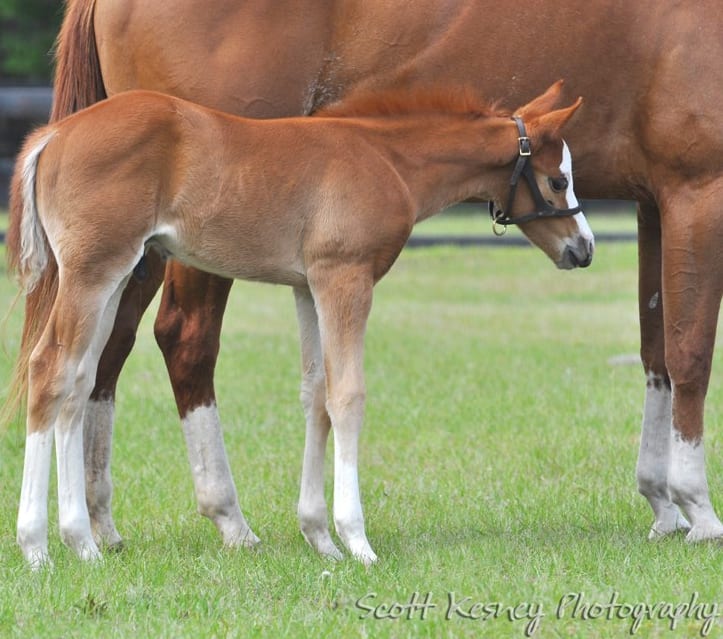 “Our customers who are in the market for a yearling are looking for a prospect that shows potential for becoming a show horse,” said Kesney.
“Our customers who are in the market for a yearling are looking for a prospect that shows potential for becoming a show horse,” said Kesney.
So your horse is ready to be marketed, is looking good, and is moving great. What’s the best way to spread the word?
Well, back in the stone ages, people would eagerly await for their preferred breed registry’s publication to come out with their weanling or yearling issue, or just any issue and flip to the back to the sale ads. Then someone might send you a tape to play in your VHS machine.
Then came websites.
And now, there is Facebook and YouTube.
Kesney said, “Facebook and YouTube are some of the most powerful tools for marketing horses; the best part is they are cost effective (free), and you can make a minimal investment to both track and boost your page.”
Pittman advises using magazine ads to direct traffic to a seller’s Facebook and YouTube pages.
In addition, she finds well-constructed and up-to-date websites are another powerful tool for directing potential buyers to your YouTube and Facebook sites. In her view, the most effective marketing plan is one that first evaluates the target market and then utilizes all available tools to channel those buyers’ search efforts accordingly.
 Of course, social media is not the only place to market your horse. Pittman is also a proponent of taking it to a show if the horse is ready.
Of course, social media is not the only place to market your horse. Pittman is also a proponent of taking it to a show if the horse is ready.
She said, “You can get great exposure, you never know who’s looking, and it’s a fun way to market and meet great people in the industry.”
It’s All About the Photos and the Video
People are busy.
And in today’s world where one can receive instant gratification via the internet, the pictures and videos you post to market your horse should be eye catching.
“Everyone looks at the world through a different set of eyes,” said Pittman. “Some people can’t get past the shaggy hair coat or an unbanded mane.”
“Seven seconds of brilliance is better than sixty seconds of mediocrity,” added Kesney. “You don’t want to present a video or photo that does not highlight the strengths of your horse.”
GOOD PICTURE BAD PICTURE
We’ve all been there, scrolling through sale ads and looking for the potential dream horse but missing it because the pictures were horrible and, generally, the video was no better.
That being said, Kesney and Pittman described the best ways to take photos and videos when marketing your horse.
“Judges see horses on the rail,” said Kesney. “So a profile photo is important. I also like to see a head shot of the horse. These two photos allow the prospective buyer to see the pieces and parts of a horse relatively quickly and, if taken properly, may encourage the buyer to look further.”
Kesney said pictures need to be taken from an advantageous angle that best show the attributes of the horse, and advises that if your horse is not ready, don’t take the photos.
“Taking photos of horses is an art form, so consider hiring a professional equine photographer,” said Pittman. “But if you choose to do your own photography, take away any distractions and make sure the background is clean. If a fence post is broken, fix it. If the grass needs mowing, mow it.”
“The footing of the area you are using is really important,” she said. “So is the time of day. If you are videoing in a field, make sure it looks good, that the ground is flat, and that the lighting is appropriate to avoid shadows. Late afternoon light is often best because it is soft and avoids harsh shadows with their high contrast. Strong back light makes the horse look much darker than it really is and destroys detail. These are some of the factors that a professional photographer is trained to consider.”
In general, five major methods exist for videoing a young horse for sale: loose in a pasture or arena, in a round pen, on a lunge line, on the side of the mare (weanlings), and an alternative method like ponying.
Kesney said which method you use, depends on the horse.
“For the most naturally talented, the pasture usually works best,” he said. “Some horses move the best without the pressure of a human; they showcase best while turned loose.”
https://www.youtube.com/watch?v=_FSmgn974wE
Then, there are horses that enjoy the security of a fence or a circle. In these cases, a round pen can suit your needs well.
“The best way to film in a round pen is to find a good angle where the camera can stay stationary,” said Kesney. “Finding the right angle is important and can be a challenge. You don’t want your horse to appear fast or display a poor top line due to the wrong camera angle.”
Yearlings that prefer the guidance of a lead are best presented on a lunge line, while yearlings that are great movers, but like to play in the pasture, generally present well ponying.
“Ponying your horse can achieve the same quality video as in the pasture,” said Kesney.
And if you have that “wow” foal that is still next to mama?
The ideal time to film is when the foal is between four and eight weeks old.
Kesney explained, “Before the fourth week, foals want to hide behind their dams, but after eight weeks they are a little more independent and more interested in playing. Lastly, make sure the broodmare is well groomed and looks good. You have one chance to present this foal, so make sure everything is right.
Did we mention people are busy?
One of the most common mistakes Pittman and Kesney see when it comes to videos is a video that is too long.
“If I’m looking for a western pleasure prospect, I like to see the lope first and then the jog,” said Pittman. “Remember, you want to engage your audience and keep their interest, but also remember what I said earlier: everyone sees the world through a different set of eyes.”
“For babies and weanlings, a video less than a minute long is all you need,” said Kesney. “Yearlings should be less than two minutes, and under-saddle horses should be showcased for approximately two minutes per event. If your horse has been successfully shown, buyers like to see your horse in the show pen.”
“If a serious buyer wants to see more, you can always take more videos or pictures,” said Pittman.
Write-Ups, Sale Price, and What NOT to Do
Bottom line: the write-up on the horse should be short and sweet and contain the vital information.
“Age, gender, breed registry, the sire and dam (mention any notable accomplishments), the programs the horse is eligible for, the horse’s location, your contact number, and if the horse has been shown and its points/earnings,” said Kesney.
Notice that what is not listed is the sale price. Some buyers do not want the purchase price to be public knowledge.
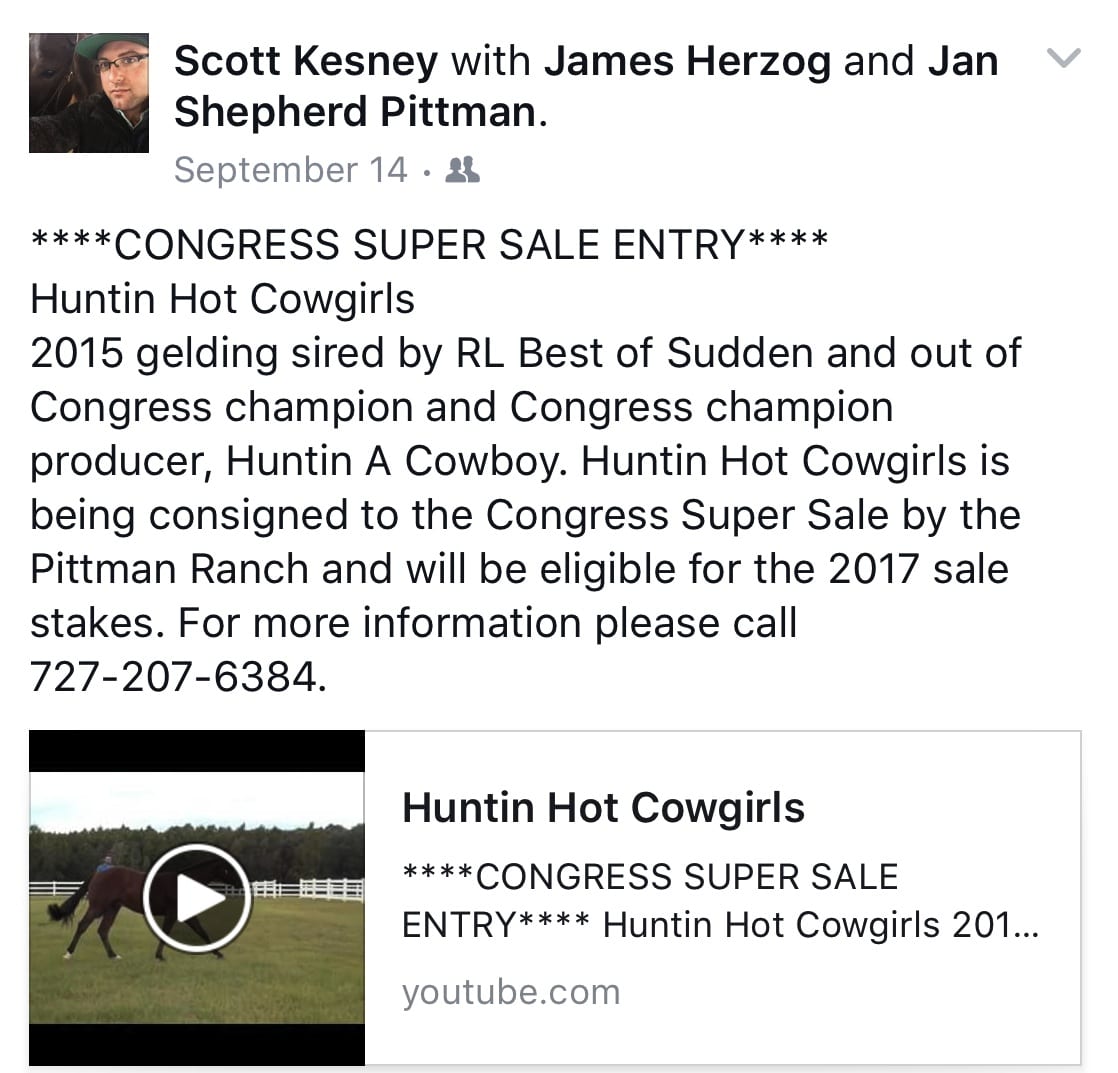 Speaking of the sale price, as a seller, how should you determine what your horse is worth?
Speaking of the sale price, as a seller, how should you determine what your horse is worth?
As the old saying goes, “Horses are worth only what someone will pay for it that day,” said Kesney.
Yet, when considering a sale price, he emphasizes the importance of considering the stud fee, whether the horse was a transferred embryo or a self-carry, whether it has a show record or what the mare’s produce record is, how well the full siblings are doing, and the cost to replace the horse.
“Price is really all relative to the individual horse, and a good horse is a good horse,” said Kesney.
Pittman added, “Sellers need to realize, however, that not every foal is going to be a great one, even if it has a great sire and dam.”
Kesney also shared two of the worst things you can do as a seller trying to market your horse (besides posting bad photos/videos).
“Talking on videos is a big no-no, and excessively altered photos or videos is a cardinal sin. Most prospective buyers can tell if a video has been slowed down. It is always best to just show your horse in its natural movement. Lost credibility leads directly to losing a sale.”
Be a Good Buyer
So, what if you are on the other side of the coin and are in the market for a new prospect?
 Ultimately, the best service you can do for yourself, as a buyer, is to be well informed. Check out the seller’s reputation.
Ultimately, the best service you can do for yourself, as a buyer, is to be well informed. Check out the seller’s reputation.
“Reputable sellers will be transparent and follow the rules of disclosure,” said Pittman. “As a seller, your reputation is going to help instill confidence and a comfort level in the buyer. When I sell a yearling sight unseen, I try to do everything I can to make the buyer comfortable with their purchase. No one like surprises. It is exciting to hear from the purchaser that they ‘love’ their new horse or that it ‘exceeded’ their expectations.”
Lastly, speaking of disclosure, one thing buyers and sellers often underestimate is the sometimes critical importance of knowing the disclosure laws.
“Knowing the laws in your state can protect both the buyer and the seller,” said Pittman. “And purchasers also need to realize that without a bill of sale, legally speaking, you may not own the horse.”
In conclusion, when presenting your horse for sale, remember to evaluate the market, use the effective marketing tools described here, take advantageous photos and videos, and be mindful of the buyer’s overall experience.
“It probably goes without saying, but buyers who have the best experiences tend to be your repeat customers,” said Pittman. “Don’t forget that ‘word of mouth’ remains a most powerful and persuasive marketing tool.”
Happy Selling and Shopping!


